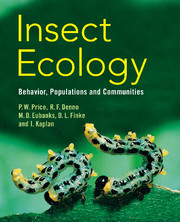Book contents
- Frontmatter
- Contents
- Preface
- Acknowledgments
- Part I Introduction
- Part II Behavioral ecology
- Part III Species interactions
- Part IV Population ecology
- Part V Food webs and communities
- 12 Community structure
- 13 Multitrophic interactions
- Part VI Broad patterns in nature
- Glossary
- References
- Author Index
- Taxonomic Index
- Subject Index
- Plate section
- References
13 - Multitrophic interactions
from Part V - Food webs and communities
Published online by Cambridge University Press: 05 June 2012
- Frontmatter
- Contents
- Preface
- Acknowledgments
- Part I Introduction
- Part II Behavioral ecology
- Part III Species interactions
- Part IV Population ecology
- Part V Food webs and communities
- 12 Community structure
- 13 Multitrophic interactions
- Part VI Broad patterns in nature
- Glossary
- References
- Author Index
- Taxonomic Index
- Subject Index
- Plate section
- References
Summary
Multitrophic interactions are those that link several (i.e., more than two) trophic levels, including plants (first trophic level), herbivores (second trophic level), and predators, parasitoids or pathogens (third trophic level and beyond; hereafter referred to as “enemies”). These types of multispecies consumer-resource dynamics are also referred to as tritrophic interactions when they specifically involve three trophic levels. Because food webs typically possess more than three trophic levels, with higher-order predators preying on intermediate predators and hyperparasitoids attacking primary parasitoids, we use “multitrophic” as an all-encompassing term that includes tritrophic interactions, but allows for the consideration of more complex food-web dynamics.
Fortunately, the individual components that comprise multitrophic interactions have already been described in some detail throughout earlier sections of this book, especially Chapters 4 through 8 (Part III: Species interactions), which address plant-herbivore interactions, competition, mutualism, predator–prey and host–parasite interactions, respectively. Also, Chapter 2 provided a conceptual foundation for the role of semiochemicals in plant–insect associations, a critical issue that we will revisit often in this chapter as insects live in a chemically mediated world. The purpose then of this chapter is to assemble these isolated units to form an integrated understanding of how plants, herbivores and enemies interact, with the explicit recognition that plants exert direct effects on the ecology of predators and parasitoids, and that indirect effects linking plants with higher trophic levels are commonplace. This has not always been the prevailing view. Historically, plant–herbivore and enemy–prey interactions were treated as two separate fields with no unifying theme. Seminal publications by Hairston et al. (1960), Price et al. (1980) and Oksanen et al. (1981), however, provided the theoretical framework that was lacking and spawned an emergence of studies over subsequent decades. As a result, the field of multitrophic interactions is among the most productive, innovative and exciting realms of insect ecology.
Information
- Type
- Chapter
- Information
- Insect EcologyBehavior, Populations and Communities, pp. 489 - 534Publisher: Cambridge University PressPrint publication year: 2011
References
Accessibility standard: Unknown
Why this information is here
This section outlines the accessibility features of this content - including support for screen readers, full keyboard navigation and high-contrast display options. This may not be relevant for you.Accessibility Information
- 1
- Cited by
